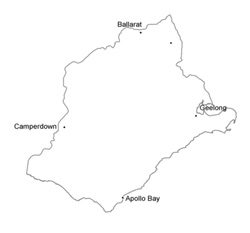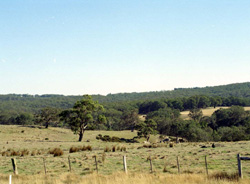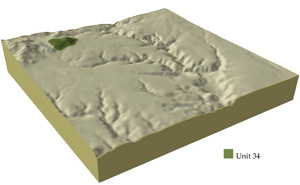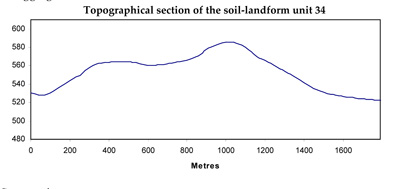Soil/Landform Unit 34
Landform Unit Description
Page top
 Mount Egerton |
0.01% of CMA region The steep low cone of Mount Egerton belongs to a suite of eruption points across the Western Uplands. With steep slopes, the cones have little remnant vegetation (less than 4%) with the major vegetation classes including Plains Grassy Woodland and Herbrich Foothill Forest. These remnants occur mainly as reserves on upper slopes and crests, and footslopes. These cones have highly fertile side slopes and footslopes that have been used for cereal production and horticulture. The basaltic rock and scoria support shallow friable red texture contrast and gradational soils on the relatively steeper middle and upper slopes. The gentler lower slopes contain patches of shallow black self-mulching clay. Overland flow is likely on the steeper slopes. Nutrient leaching and decline are possible due to the shallow and permeable nature of gradational soils. |  |
 Stony lower slopes of these cones have some surface stone and are prone to waterlogging |  |
|
Component | 1 | 2 | 3 | 4 |
Proportion of soil-landform unit | 60% | 37% | 2% | 1% |
| CLIMATE Rainfall (mm) | Annual: 710 | |||
| Temperature (oC) | Minimum 7, Maximum 17 | |||
| Precipitation less than potential evapotranspiration | October-March | |||
| GEOLOGY Age and lithology | Quaternary scoria and basalt | |||
| Geomorphology | ||||
| LANDUSE | Uncleared; Nature conservation; passive recreation; water supply; forest grazing Cleared: Beef cattle and sheep grazing; water supply; cropping (cereal); horticulture (including potatoes) | |||
| TOPOGRAPHY Landscape | Steep low cones | |||
| Elevation range (m) | 507-590 | |||
| Local relief (m) | 60 | |||
| Drainage pattern | Radial and shut flow (poorly developed channels) | |||
| Drainage density (km/km2) | - | |||
| Landform | Volcanic cone | Dissected plain and lower slopes | ||
| Landform element | Slope and crest | Long gentle upper slopes | Depressions | Stony rises |
| Slope and range (%) | 25 (5-40) | 2 (1-3) | 1 (1-2) | 3 (2-5) |
| Slope shape | Straight | Straight | Straight | Convex |
| NATIVE VEGETATION Ecological Vegetation Class | Plains Grassy Woodland (3.3%), Herb-rich Foothill Forest (0.4%) | |||
| Dominant species | E. ovata, E. viminalis, E. rubida, E. obliqua | |||
| SOIL Parent material | In situ weathered basalt and scoria | In situ weathered basalt | Alluvium | In situ weathered basalt |
| Description (Corangamite Soil Group) | Stony red gradational soils (40) | Black cracking clay soil, coarse structure (31) | Red shallow, stony gradational soil (40) | |
| Soil type sites | ||||
| Surface texture | Clay loam | Clay loam | Clay | Clay loam |
| Permeability | High | Moderate to low | Moderate | High |
| Depth (m) | 1 | 1.5 | 1.5 | 0.5 |
| LAND CHARACTERISTICS, POTENTIAL AND LIMITATIONS | Steep slopes causing overland flow is likely to cause sheet and rill erosion. Nutrient decline is possible due to shallow and permeable soils. | Hardsetting surfaces and low permeability leads to overland flow. This flow often creates sheet and rill erosion with major rainfall events. Gully erosion and leaching of salts also occur. Surface compaction can benefit from controlled traffic. | Clay soils beside creeks are prone to waterlogging. Streambank undercutting and streambank erosion can occur with excessive rains and inadequate ground coverage. | Overland flow is likely to cause sheet and rill erosion. Nutrient decline is possible due to shallow and permeable soils. |



